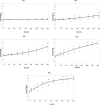Modelling the Growth Rate of Listeria Monocytogenes in Cooked Ham Stored at Different Temperatures
- PMID: 29978054
- PMCID: PMC5894405
- DOI: 10.1515/jvetres-2017-0006
Modelling the Growth Rate of Listeria Monocytogenes in Cooked Ham Stored at Different Temperatures
Abstract
Introduction: The purpose of the study was to determine and model the growth rates of L. monocytogenes in cooked cured ham stored at various temperatures.
Material and methods: Samples of cured ham were artificially contaminated with a mixture of three L. monocytogenes strains and stored at 3, 6, 9, 12, or 15ºC for 16 days. The number of listeriae was determined after 0, 1, 2, 3, 5, 7, 9, 12, 14, and 16 days. A series of decimal dilutions were prepared from each sample and plated onto ALOA agar, after which the plates were incubated at 37ºC for 48 h under aerobic conditions. The bacterial counts were logarithmised and analysed statistically. Five repetitions of the experiment were performed.
Results: Both storage temperature and time were found to significantly influence the growth rate of listeriae (P > 0.01). The test bacteria growth curves were fitted to three primary models: the Gompertz, Baranyi, and logistic. The mean square error (MSE) and Akaike's information criterion (AIC) were calculated to evaluate the goodness of fit. It transpired that the logistic model fit the experimental data best. The natural logarithms of L. monocytogenes' mean growth rates from this model were fitted to two secondary models: the square root and polynomial.
Conclusion: Modelling in both secondary types can predict the growth rates of L. monocytogenes in cooked cured ham stored at each studied temperature, but mathematical validation showed the polynomial model to be more accurate.
Keywords: Listeria monocytogenes; ham; predictive modelling; storage.
Conflict of interest statement
Conflict of Interests Statement: The authors declare that there is no conflict of interests regarding the publication of this article.
Figures



Similar articles
-
Modeling the effect of temperature on survival rate of Listeria monocytogenes in yogurt.Pol J Vet Sci. 2016;19(2):317-24. doi: 10.1515/pjvs-2016-0039. Pol J Vet Sci. 2016. PMID: 27487505
-
New insights on Listeria monocytogenes growth in pressurised cooked ham: A piezo-stimulation effect enhanced by organic acids during storage.Int J Food Microbiol. 2019 Feb 2;290:150-158. doi: 10.1016/j.ijfoodmicro.2018.10.008. Epub 2018 Oct 6. Int J Food Microbiol. 2019. PMID: 30340113
-
Determination of the growth limits and kinetic behavior of Listeria monocytogenes in a sliced cooked cured meat product: validation of the predictive growth model under constant and dynamic temperature storage conditions.J Food Prot. 2006 Jun;69(6):1312-21. doi: 10.4315/0362-028x-69.6.1312. J Food Prot. 2006. PMID: 16786851
-
Predictive Model of Listeria monocytogenes Growth in Queso Fresco.J Food Prot. 2019 Dec;82(12):2071-2079. doi: 10.4315/0362-028X.JFP-19-185. J Food Prot. 2019. PMID: 31714806
-
A mathematical model to predict the antilisteria bioprotective effect of Latilactobacillus sakei CTC494 in vacuum packaged cooked ham.Int J Food Microbiol. 2022 Feb 16;363:109491. doi: 10.1016/j.ijfoodmicro.2021.109491. Epub 2021 Nov 24. Int J Food Microbiol. 2022. PMID: 34862040
Cited by
-
New Insights into Listeria monocytogenes Antimicrobial Resistance, Virulence Attributes and Their Prospective Correlation.Antibiotics (Basel). 2022 Oct 21;11(10):1447. doi: 10.3390/antibiotics11101447. Antibiotics (Basel). 2022. PMID: 36290105 Free PMC article.
-
Evaluation of Commercial Anti-Listerial Products for Improvement of Food Safety in Ready-to-Eat Meat and Dairy Products.Antibiotics (Basel). 2023 Feb 20;12(2):414. doi: 10.3390/antibiotics12020414. Antibiotics (Basel). 2023. PMID: 36830324 Free PMC article.
-
Listeria monocytogenes Biofilm Adaptation to Different Temperatures Seen Through Shotgun Proteomics.Front Nutr. 2019 Jun 14;6:89. doi: 10.3389/fnut.2019.00089. eCollection 2019. Front Nutr. 2019. PMID: 31259174 Free PMC article.
-
Occurrence and molecular characteristics of Listeria monocytogenes isolated from ready-to-eat meats in Hanoi, Vietnam.Ital J Food Saf. 2020 Oct 16;9(3):8772. doi: 10.4081/ijfs.2020.8772. eCollection 2020 Oct 16. Ital J Food Saf. 2020. PMID: 33117740 Free PMC article.
-
Risk factors for listeriosis due to sausage consumption in Mexico: consumer practices, bacterial survival, and quantitative microbial risk assessment.Braz J Microbiol. 2023 Sep;54(3):2163-2171. doi: 10.1007/s42770-023-01066-3. Epub 2023 Jul 16. Braz J Microbiol. 2023. PMID: 37454392 Free PMC article.
References
-
- Ahmed O., Pangloli P., Hwang C., Zivanovic S., Wu T., D'Souza D., Draughon F.A.. The occurrence of Listeria monocytogens in retail ready-to-eat meat and poultry products related to the levels of acetate and lactate in the products. Food Control. 2014 http://dx.doi.org/10.1016/j.foodcont.2014.12.015 - DOI
-
- Baranyi J., Roberts T.A.. A dynamic approach to predicting bacterial growth in food. Int J Food Microbiol. 1994;23:277–294. - PubMed
-
- Berger S. GIDEON Informatics, Inc; Los Angeles: 2016. Listeriosis: Global Status.
-
- Black D.G., Davidson P.M.. Use of modeling to enhance the microbiological safety of the food system. Compr Rev Food Sci Food Saf. 2008;7:159–167.
-
- Buchanan R.L., Phillips J.G.. Response surface model for predicting the effects of temperature, pH, sodium chloride content, sodium nitrite concentration, and atmosphere on the growth of Listeria monocytogenes. J. Food Protection. 1990;53:370–376. http://wyndmoor.errc.ars.usda.gov/pubs/viewpub.aspx?iden=5478 - PubMed
LinkOut - more resources
Full Text Sources
Other Literature Sources
